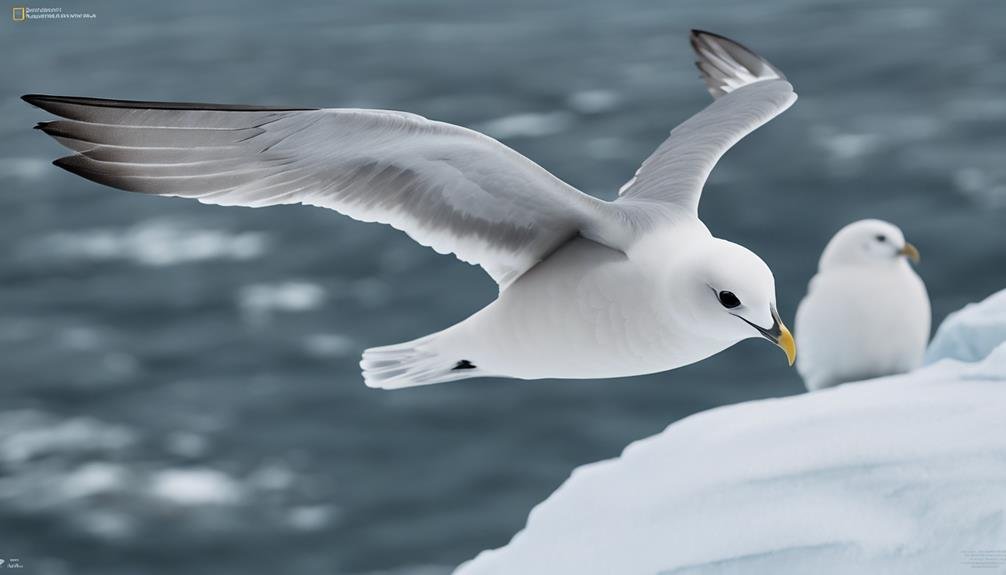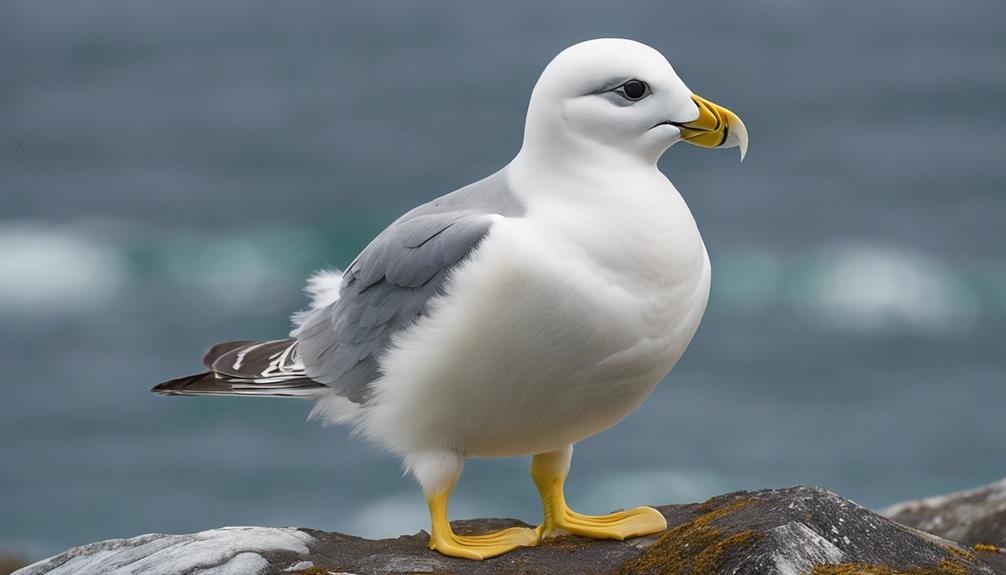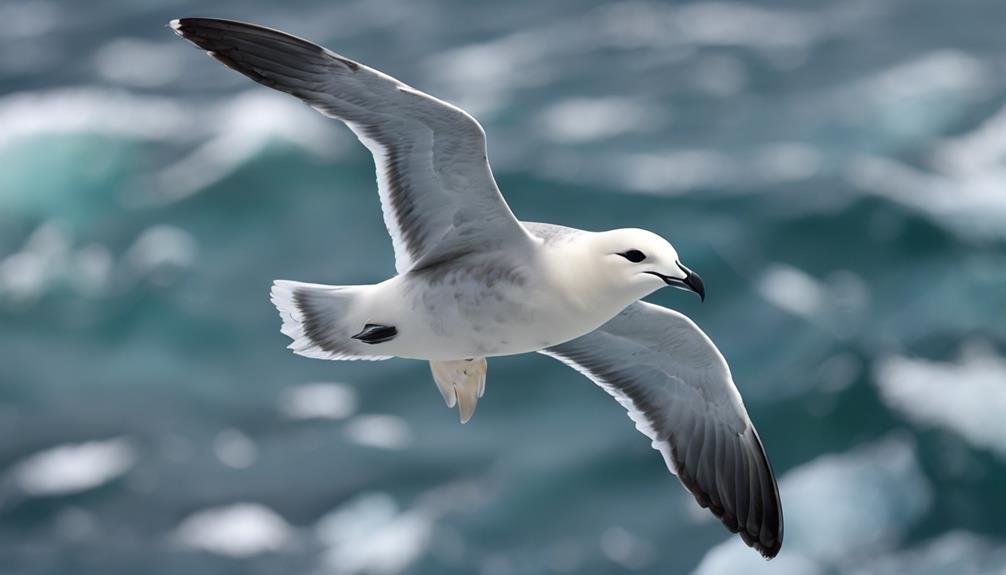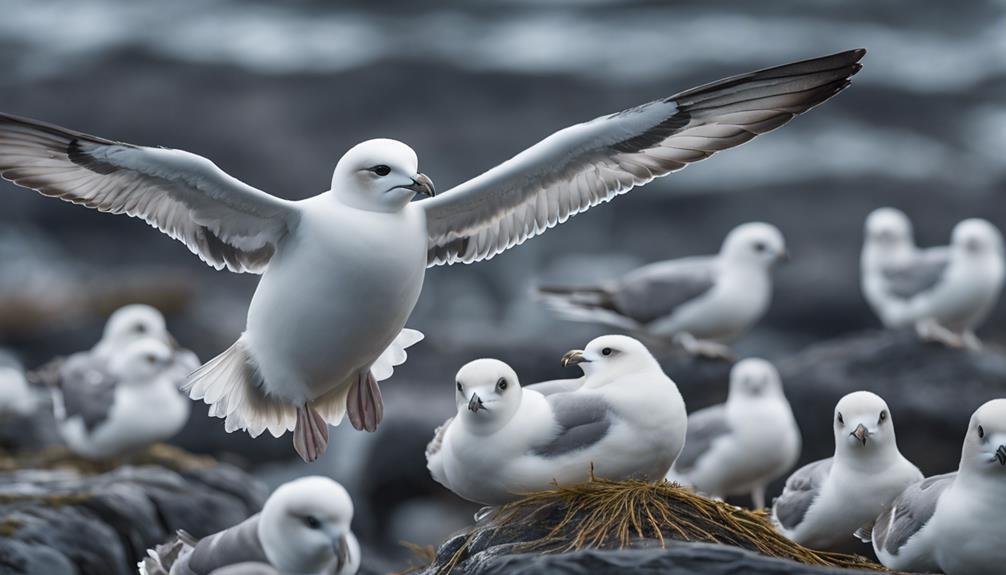What drives the resilience of the Northern Fulmar in its marine environment? In an age where the natural world faces myriad challenges, understanding the role and characteristics of this species becomes imperative. The Northern Fulmar, a seabird thriving in the North Atlantic and Pacific Oceans, serves as a testament to the adaptability and complexity of marine life.
This seabird, with a weight ranging between 450-1000 grams and a wingspan of approximately 100 to 112 cm, demonstrates a remarkable ability to navigate vast and changing seas. Its diet is diverse, including fish, carrion, mollusks, and planktonic organisms, highlighting its importance in the food web and its impact on the health of marine ecosystems. The social behavior and breeding patterns of the Northern Fulmar—notably its monogamous relationships and formation of large colonies—offer insights into avian social structures and their survival strategies.
At a high level, the existence and behavior of the Northern Fulmar underscore the interconnectedness of marine ecosystems and the critical need for conservation efforts. As climate change poses increasing threats to their habitats, the future of these seabirds hinges on our understanding and actions towards environmental stewardship.
Key Takeaways
Key Takeaways:
- The Northern Fulmar is an integral part of its ecosystem, demonstrating high levels of adaptability to environmental changes.
- These birds are monogamous and rely on large group dynamics for effective breeding and survival.
- A varied diet allows them to be flexible in their feeding habits, consuming everything from fish to plankton.
- Due to their long lifespan, Northern Fulmars are particularly susceptible to sustained environmental challenges.
- Conservation efforts are imperative to protect their habitats in the North Atlantic and North Pacific regions against climate change threats.
This emphasizes the need for focused conservation strategies to ensure the Northern Fulmar’s continued presence in its natural habitat.
Scientific Classification
Understanding the Northern Fulmar’s Taxonomy
The Northern Fulmar, scientifically known as Fulmarus glacialis, is a remarkable seabird that thrives in the cold-water habitats of both the North Atlantic and North Pacific oceans. This species is part of the Procellariiformes order and falls under the Procellariidae family, grouping it with other seabirds like the Great Shearwater and the Sooty Shearwater. The taxonomy of the Northern Fulmar reveals much about its ecological niche and evolutionary lineage within these marine ecosystems.
Characteristics and Behavior of Fulmarus Glacialis
Sporting a robust body and long wings, the Northern Fulmar is adept at long-distance foraging flights, a trait shared with its relatives in the Shearwaters and Petrels group. This bird’s exceptional navigational skill set and its ability to adapt to the marine environment highlight the evolutionary marvels of the Procellariidae family. The Northern Fulmar’s classification isn’t just a matter of scientific nomenclature but a key to understanding its behaviors, diet, and migration patterns.
Significance of Scientific Classification
The precise classification of the Northern Fulmar within the realms of Procellariiformes and Procellariidae shines a spotlight on its close genetic connections to other members of its group. This understanding is pivotal for the conservation efforts directed towards these seabirds. Recognizing the Northern Fulmar’s place in the broader ecological web enables researchers and policymakers to devise strategies that protect not only this species but also the health of the marine ecosystems they inhabit.
Habitat

Adaptability Across Oceans
Subarctic Marine Mastery: The Northern Fulmars are masters of the subarctic waters, thriving in both the North Atlantic and North Pacific oceans. This wide range showcases their ability to adapt and flourish in a variety of marine settings, from the expansive, open oceanic pelagic zones to more sheltered coastal and neritic areas. Their life cycle intricately intertwines with these diverse habitats, demonstrating a seamless transition from one environment to another to meet their living requirements.
Geographical Versatility: Unlike species that are tethered to specific locales, Northern Fulmars are geographical roamers. Their presence spans the hemispheres, marking them as true global voyagers. This geographical flexibility is a testament to their survival strategy, enabling them to tap into the bounty of different marine ecosystems for nesting, foraging, and migration purposes.
Life in Varied Waters:
Oceanic Life: In the vastness of the ocean, Northern Fulmars are the epitome of aerial grace. Spending much of their existence over open waters, they’re adept at utilizing the air currents, gliding with minimal effort. This skill not only conserves energy but also aids in their extensive search for food across the ocean’s surface.
Coastal Existence: The rocky shores and cliffs of coastal regions are more than just landscapes for the Northern Fulmars; they’re crucial nesting grounds. These areas provide the safety and seclusion needed for their breeding seasons, underscoring the importance of coastal habitats in their lifecycle.
Neritic Zone Foraging: Close to the shores, the neritic zone offers a rich foraging ground teeming with life. This proximity to land supports the Northern Fulmars’ diurnal feeding habits, allowing them to access abundant food resources to sustain their energy-intensive lifestyles.
Inhabiting such a wide array of marine environments, Northern Fulmars aren’t just participants but key players in their ecosystems. Their presence and activities contribute significantly to the marine food web, highlighting their ecological importance in maintaining the balance within their diverse habitats.
Diet

Diverse Diet of the Northern Fulmar
Exploring the Northern Fulmar’s diet, we uncover a fascinating array of fish, squid, and small crustaceans. These seabirds navigate their marine environment efficiently, opting for prey that the sea generously offers. Their diet doesn’t stop there; it’s enriched with mollusks like shrimp, marine worms, and a kaleidoscope of plankton species. This eclectic menu showcases the Northern Fulmar’s opportunistic feeding strategy, allowing them to thrive in their habitats.
Scavenging: A Vital Ecological Role
In addition to their regular diet, Northern Fulmars partake in scavenging. They consume carrion, jellyfish, and other marine invertebrates, embracing their role as cleaners of the ocean. This behavior not only aids in the removal of dead or decaying matter but also underscores the seabirds’ contribution to maintaining the balance within marine ecosystems.
Adaptability to Human Influence
A remarkable aspect of the Northern Fulmar’s behavior is their adaptability to human presence. These birds have learned to feed on refuse and follow fishing vessels for discarded scraps. This adaptability indicates their resilience and the ability to exploit new resources, highlighting the impact of human activities on marine life.
Impact on Marine Ecosystems
The Northern Fulmar’s varied diet and feeding habits play a critical role in nutrient recycling within marine ecosystems. Their interactions within the food web illuminate the interconnectedness of life under the sea and the importance of preserving diverse and balanced marine environments for the health of our planet.
Behaviour

Exploring the Behavior of Northern Fulmars, we uncover that these oceanic birds masterfully employ a combination of diving and surface skimming to secure their meals, illustrating their adaptability in hunting methods. Their conduct undergoes a significant transformation during the breeding season, characterized by a series of intricate and specialized actions. Let’s delve into three critical aspects of their behavior:
- Loyalty in Partnerships and Nest Selection: Northern Fulmars are distinguished by their strong sense of devotion, not solely towards their mates but also regarding their nesting locations. They engage in monogamous relationships, consistently returning to the same spot each year to reproduce. This commitment enhances the bond between pairs and ensures effective parental collaboration.
- Role in Egg Incubation and Young Nurturing: The process of incubating the solitary white egg they produce takes around 50 days. Both parents are involved in this phase, alternating responsibilities to keep the egg at the correct temperature. After the egg hatches, they demonstrate a remarkable dedication to feeding the chick, with one parent guarding the nest while the other searches for food at sea.
- Adaptation in Reproduction Timing: An intriguing aspect of their reproductive behavior is the female’s capacity to postpone pregnancy post-mating. This adjustment ensures the timing of egg-laying aligns with favorable environmental conditions, enhancing the chances of their offspring’s survival.
Through these behaviors, Northern Fulmars reveal a sophisticated combination of adaptation and strategy, securing their reproductive success and the continuation of their species.
Conservation

Challenges Facing Northern Fulmars
Despite their seemingly large global breeding population of 14 million birds, Northern Fulmars are navigating through treacherous waters due to human-induced threats. With a Continental Concern Score of 9 out of 20, these seabirds aren’t on the edge of extinction yet, but their situation is far from secure. The survival and prosperity of these birds are hampered by several factors, with oil spills and plastic ingestion at the forefront.
Oil Spills: A Deadly Menace
Oil spills rank among the most catastrophic events for Northern Fulmars. These incidents result in immediate death for many birds, while survivors suffer from prolonged health complications and diminished reproductive success. The sticky oil clings to their feathers, impeding their ability to fly, maintain body temperature, and hunt for food, leading to a slow and painful demise.
The Peril of Plastic
The ingestion of plastic is another grave concern. Northern Fulmars often mistake small pieces of plastic for food while foraging. These plastic particles can cause internal injuries and introduce toxic substances into their bodies, severely impacting their health and reducing their chances of survival. The prevalence of plastic waste in marine environments makes this threat particularly insidious and widespread.
Toward Conservation Efforts
The need for focused conservation strategies is evident. Targeted actions such as minimizing plastic waste and enhancing oil spill response measures are vital steps forward. However, these efforts should be part of a broader initiative to mitigate human impact on marine ecosystems. Protecting Northern Fulmars involves safeguarding their habitats and addressing the root causes of pollution and environmental degradation. Through comprehensive and multifaceted conservation approaches, the hope for a safer future for Northern Fulmars remains alive.
Climate Change Impacts

Understanding the Impact of Climate Change on Northern Fulmars
Habitat Shifts and New Challenges:
Climate change is compelling Northern Fulmars to seek new territories, indicating significant shifts in their natural habitats. This movement is born out of the necessity to find conditions that support their survival and reproductive success. The search for these new habitats is a testament to their resilience but also highlights the challenges they face in adapting to a warmer planet.
Growth Trends in the Eastern North Atlantic:
Observations have recorded a notable increase in the population of Northern Fulmars in the eastern North Atlantic. This trend is a direct reflection of how changing climate conditions can influence the distribution and numbers of marine species. It’s a dynamic situation that showcases the adaptability of Northern Fulmars, yet underscores the unpredictability of ecosystem responses to climate change.
Enhanced Vulnerability and the Need for Targeted Conservation:
The vulnerability of Northern Fulmars to climate change underscores the urgent need for targeted conservation strategies. These strategies must be adaptable and forward-looking, taking into account the anticipated shifts in the birds’ range. Protecting these seabirds requires a deep understanding of their ecological needs, threats they face, and the likely future scenarios of their habitats.
This narrative sheds light on the complex interplay between climate change and the survival of Northern Fulmars. It emphasizes the necessity of adopting adaptive conservation measures that can safeguard these seabirds amid the uncertainties of a changing environment.
Other Interesting Facts

Resilience Through Longevity
Northern Fulmars are a testament to the power of resilience, with lifespans that can extend up to an impressive 50 years. This longevity isn’t just a number; it represents their ability to adapt and thrive in the challenging conditions of their maritime environments. Their long lives allow them to experience and adjust to various changes in their habitats, demonstrating a remarkable survival strategy that has ensured their continued presence in the harsh climates they call home.
Thriving Populations Across Oceans
With an estimated breeding population of about 20 million individuals, Northern Fulmars showcase their robustness and adaptability. This substantial figure points to a species that has mastered the art of nesting and surviving across the vast expanses of the North Atlantic and North Pacific oceans. Their skill in establishing nests in diverse coastal terrains speaks volumes about their flexibility and resilience, further emphasizing their success in navigating the challenges posed by their environment.
Masters of Long-Distance Flight
The ability of Northern Fulmars to undertake extensive flights across oceans is another feather in their cap. Their proficiency in diurnal soaring, leveraging oceanic winds to glide effortlessly and conserve energy, underscores their efficiency as long-distance fliers. This skill is crucial for accessing distant feeding grounds and maintaining the intricate migratory paths that link their breeding and foraging zones. The Northern Fulmar’s adeptness at long-haul flights is a clear indication of their extraordinary adaptation to the vast and unpredictable marine landscape they inhabit.
What is the Relationship Between Svalbard Reindeer and Northern Fulmars?
The relationship between Svalbard reindeer and Northern fulmars is an important aspect of the arctic ecosystem. The Svalbard reindeer in depth relies on the Northern fulmars for ecosystem services, such as nutrient cycling and seed dispersal, while the fulmars benefit from the reindeer as a food source. This intricate connection highlights the interdependence of species in the Arctic.
Frequently Asked Questions
What Are Some Interesting Facts About the Northern Fulmar?
Q: What unique flying behavior is observed in Northern Fulmars?
A: Northern Fulmars exhibit a distinctive flying behavior where they utilize wind currents to glide through the air effortlessly, eliminating the need for constant wing flapping.
Q: How do Northern Fulmars mate and reproduce?
A: They form monogamous pairings, staying loyal to a single partner, and lay only one egg per breeding season, focusing all their care on nurturing this single offspring.
Q: Are there variations in the plumage of Northern Fulmars?
A: Yes, Northern Fulmars display a range of plumage colors, from light shades to much darker hues, showcasing a significant variation among individuals.
What Do Northern Fulmars Eat?
Q: What do Northern Fulmars eat?
A: Northern Fulmars have a varied diet that includes fish, squid, and small crustaceans. They are skilled at finding their prey and can also eat carrion, mollusks, and planktonic organisms.
How Big Are Fulmar Birds?
How much do fulmar birds weigh and how long are they?
Fulmar birds have a weight range of 450-1000 grams and a length span of 39-50 cm. Their size contributes to their impressive flight capabilities and adaptability in various environments.
What Is the Lifespan of a Northern Fulmar?
Q: How long do Northern Fulmars live?
A: Northern Fulmars have a lifespan that typically ranges between 34 to 50 years. This longevity allows them to engage in complex mating rituals and helps in sustaining their population, ensuring their status remains stable.
Do Northern Fulmars and Snowy Owls Share Similar Adaptations for Cold Environments?
Northern Fulmars and Snowy Owls both exhibit remarkable adaptations to thrive in icy habitats. While fulmars use their dense feathers to retain heat during long oceanic flights, snowy owl characteristics include thick plumage and efficient hunting in snowy terrains, ensuring survival in cold, harsh Arctic environments.
How Do the Arctic Tern and Northern Fulmar Adapt to Cold Environments?
The Arctic Tern and Northern Fulmar thrive in cold environments due to their specialized adaptations. The Arctic Tern migrates vast distances to avoid severe winters. Meanwhile, the Northern Fulmar’s dense plumage provides insulation from freezing temperatures. One of the *arctic tern interesting facts* is its ability to travel up to 25,000 miles a year!
How Do Arctic Char and Northern Fulmar Adapt to Harsh Arctic Environments?
Arctic char and Northern fulmar have remarkable adaptations for surviving in the harsh Arctic. Arctic char has antifreeze proteins in its blood to endure freezing waters, while Northern fulmar can desalinate seawater with specialized glands. For more detailed arctic char information, studying its physiology reveals even more fascinating survival mechanisms.
Conclusion
The Northern Fulmar plays a pivotal role in its ecosystem, showcasing remarkable adaptability in the face of changing environmental conditions. These birds, known for their monogamous nature, thrive in large groups that are essential for successful breeding and survival.
Their diverse diet, ranging from fish to plankton, further reflects their adaptability. Yet, their longevity makes them particularly vulnerable to prolonged environmental threats. Protecting their habitats and addressing climate change are vital steps needed to preserve their populations in the North Atlantic and North Pacific oceans.
This summary underscores the importance of concerted conservation efforts to safeguard the future of the Northern Fulmar.


